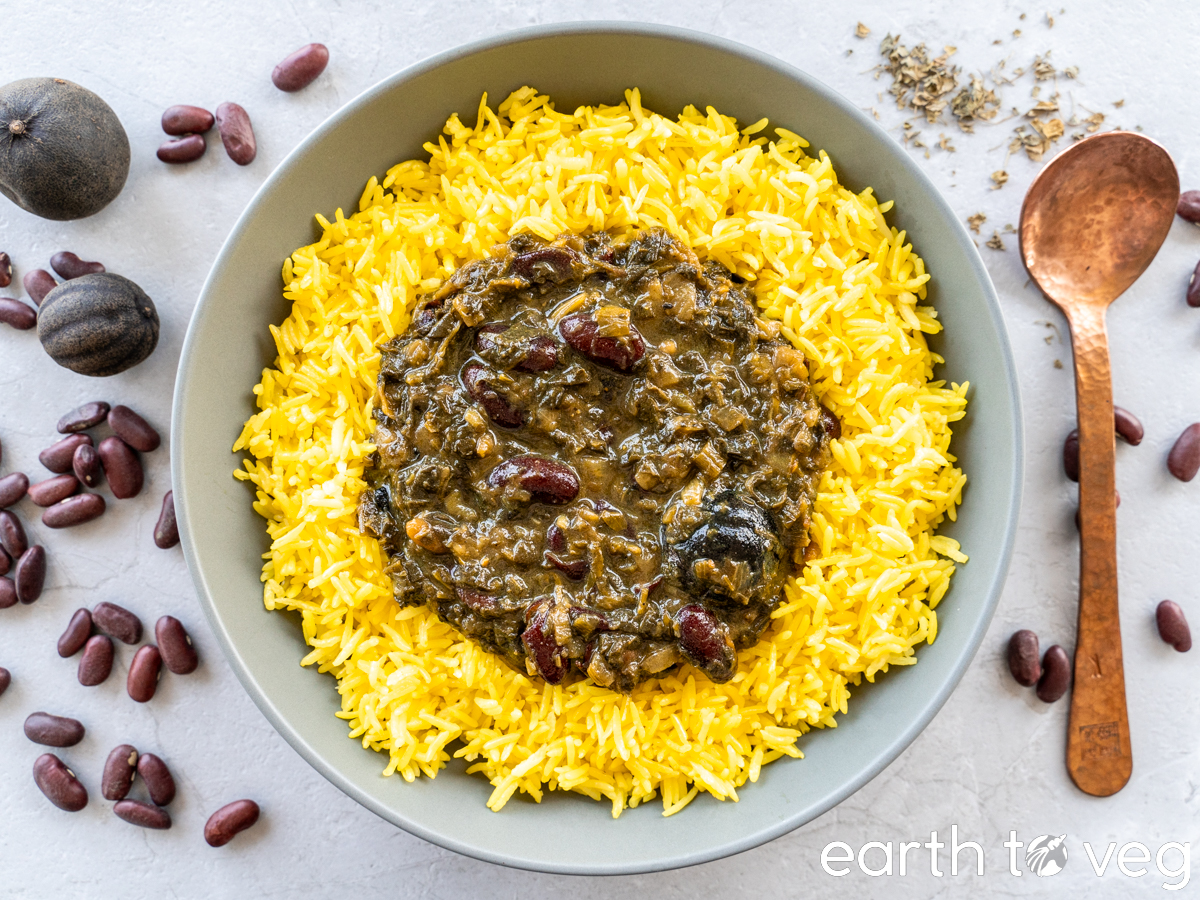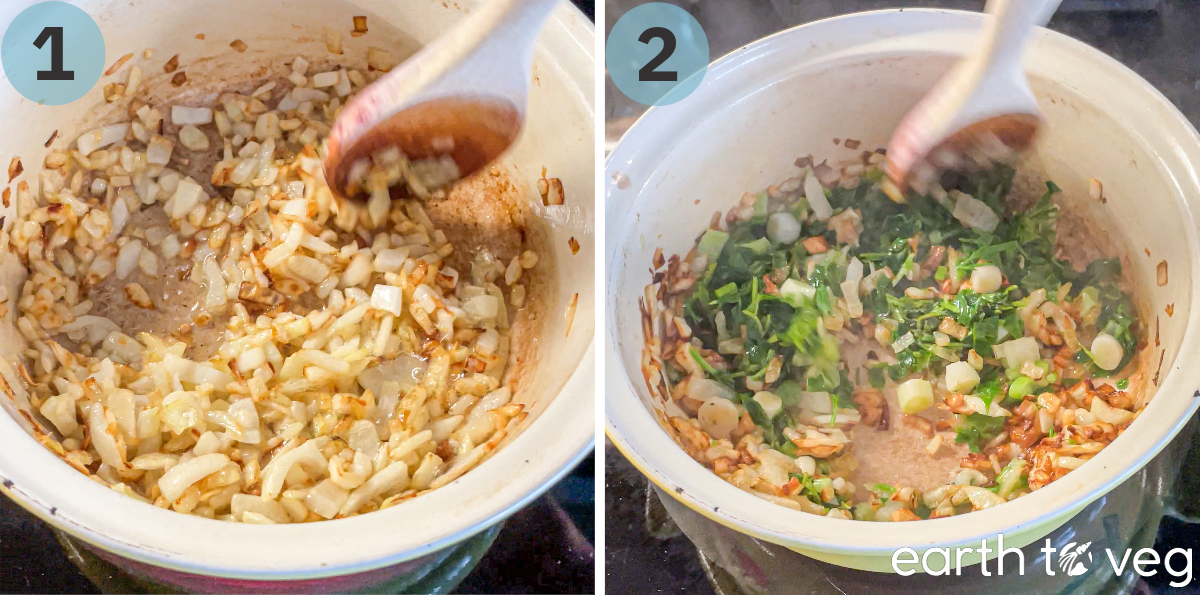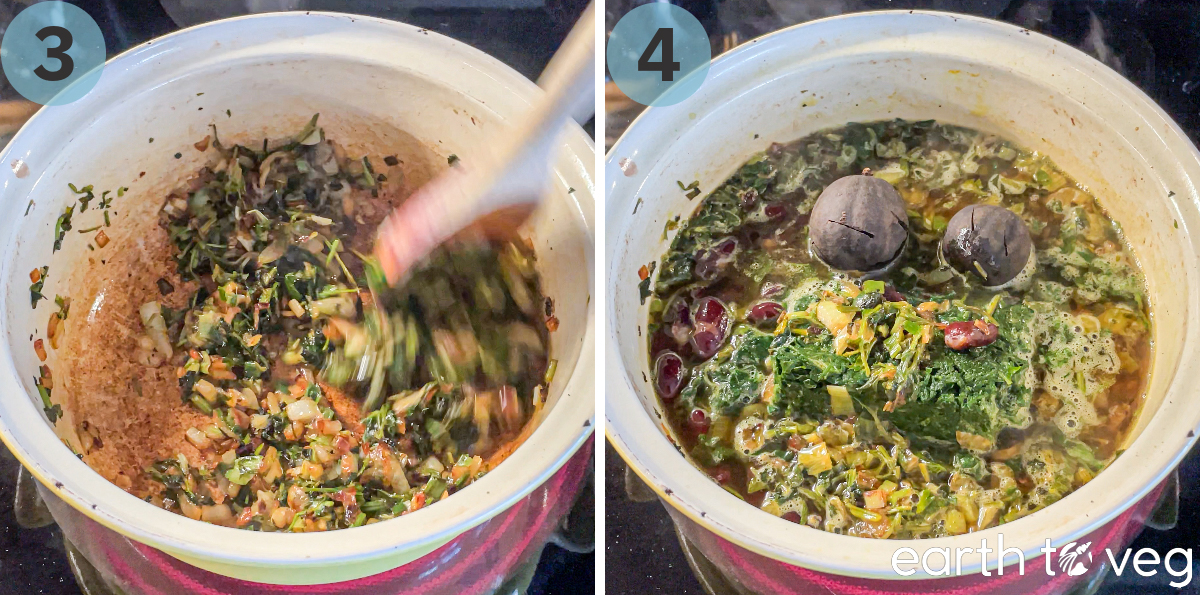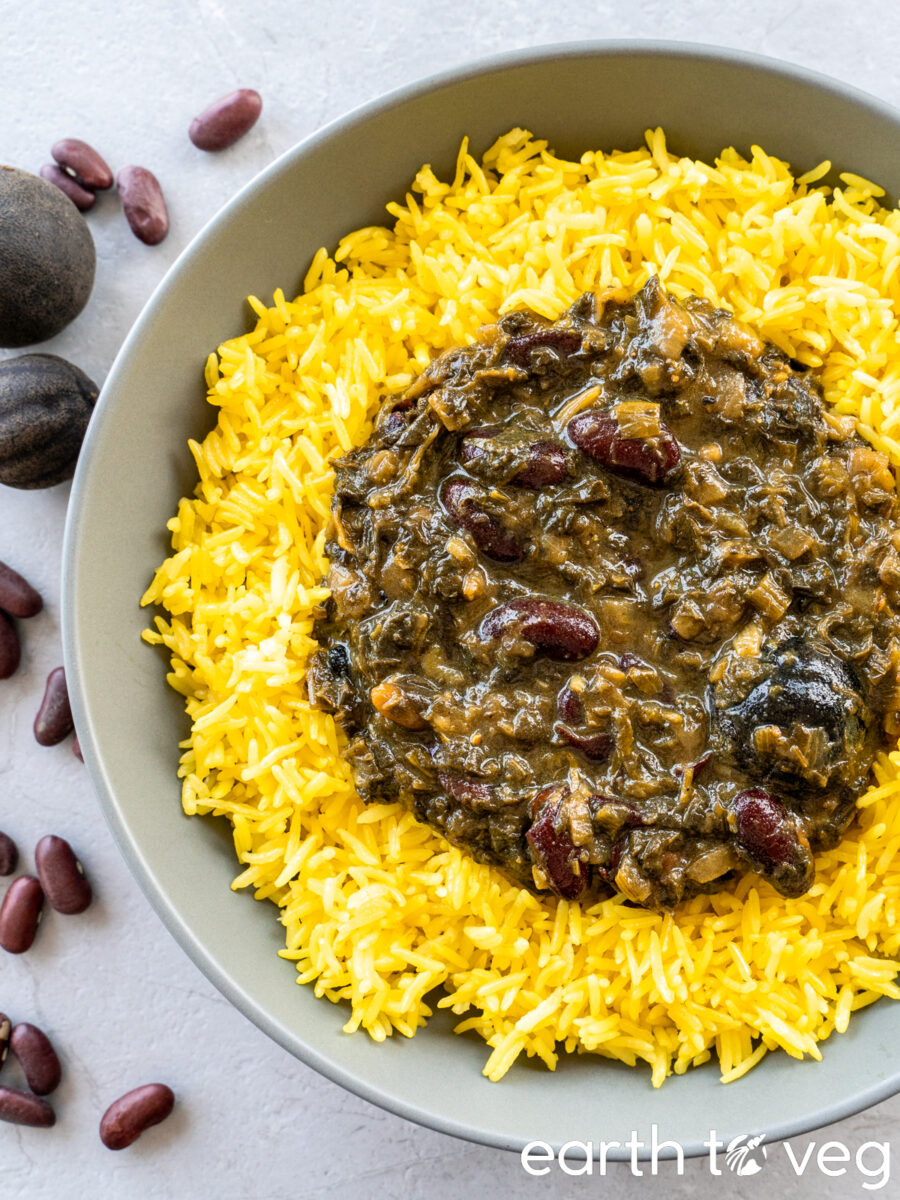Ghormeh Sabzi, or Qormeh Sabzi, is Iran’s national stew. In Farsi, it’s called قورمه سبزی and it was traditionally a way for nomadic peoples to preserve meat. A few changes later, and here we have a vegetarian and vegan-friendly version of the most beloved Persian dish! Serve this sumptuous herb stew with lots of Persian Tahdig or simple Stovetop Basmati Rice.

Why Make Ghormeh Sabzi?
- Use up leftover herbs: That cilantro wilting in the back of your fridge? Those last stalks of scallions from your backyard garden? The frozen block of spinach that’s lingered in your freezer for the last 6 months? Throw ‘em into this stew. In fact, whenever I buy a bunch of herbs I chop and freeze a cup or two because I know, sooner or later, I’ll be making ghormeh sabzi again.
- Rich and comforting: After being well-sautéed then braised for an hour, the texture of this Persian stew is transformed. The herbs become so soft and lush. The beans are perfectly tender. And the dried limes, which are so crucial in Iranian cuisine, add a note of something different. Mix vegetarian ghormeh sabzi into a big pot of rice, and it’s just incredible.
- Specifically, make it in November: The last Saturday of each November is International Ghormeh Sabzi Day. Yes, there is a whole holiday dedicated to this dish. It’s an unofficial holiday celebrated by the Iranian diaspora to bring more awareness and appreciation to Persian cuisine.
What You’ll Need

A few important notes on some of the ingredients used in this Vegetarian Ghormeh Sabzi:
Oil: Use a neutral-tasting oil, like grapeseed oil or sunflower seed oil, to sauté the herbs and spinach before stewing them. Do not skimp on the oil. It adds the rich flavour and luxurious mouthfeel that a good ghormeh sabzi needs.
Spinach: Both baby spinach and mature spinach work great. You can substitute fresh spinach with a block of frozen spinach. No need to defrost before cooking, just throw it into the pot and let it simmer.
Herbs: I like to use a mix of cilantro, parsley, and scallions. Make sure to chop the herbs up real fine. You don’t want any long stems sticking out from your ghormeh sabzi.
Tip: Do you, like me, struggle to finish your bag of fresh herbs before they wilt? Frozen greens do great in qormeh sabzi, so chop them up and freeze for the next time you make this stew. This way you’ll always have some herbs ready on hand.
Dried fenugreek leaves: Can be found at your local Indian or Middle Eastern grocery store, or ordered online. A 2 ounce bag can last you a very long time. Can substitute with 1 cup fresh fenugreek leaves (sauté it together with the other herbs). Or just leave it out, no biggie.
Spices: Turmeric, black pepper, salt, and MSG. I highly recommend including the MSG. Why? Traditionally ghormeh sabzi uses meat which adds a ton of umami to the dish. I’ve experimented with several protein alternatives, from mushrooms to seitan to tofu, but ultimately I preferred the version where I left out the meat substitute altogether. It’s a bit of a cheat but MSG is safe to use (unless you have an allergy) so why not make food tastier if you can? I use the Ajinomoto brand.
Red Kidney Beans: You can use any variety of beans for vegan ghormeh sabzi, but red kidney beans are by far the most popular. Use canned beans or beans that have been soaked overnight.
Iranian Dried Lime (Limoo Amani or Limu Omani)

Dried limes are an important ingredient in Persian cooking, where many dishes are characterized by their sour flavour. These sun-dried limes give ghormeh sabzi its traditional tanginess. Add a teaspoon of dried lime powder for a more intense flavour. Persian dried limes come in black or yellow; the black ones are dried a little longer and have a slightly stronger taste, but they’re basically interchangeable.
I usually use Sadaf brand, which sells both black and yellow varieties. These things pretty much last forever, as long as they are kept away from moisture. So even if you only cook Persian food occasionally, it’s worth keeping a package in the pantry.
To help release their flavour, use a knife to pierce a few holes into each lime. But please be careful! These limes are rock hard and it’s easy for the knife to slip and cut your hand. Wear cut-resistant kitchen gloves (this is the pair I own from NoCry), or use a fork to make the holes instead. Or just leave them un-punctured, a bit of extra flavour is not worth stabbing yourself over.
For a full list of ingredients and quantities, refer to the recipe card at the bottom of this post.
Step-by-Step Process

Step 1: Heat oil in a stock pot or Dutch oven. Sauté onions until they start to brown.
Step 2: To the same pot, add spinach, cilantro, parsley, scallions, turmeric, and black pepper.

Step 3: Sauté until the herbs are looking very dry. Most of the moisture should be cooked off.
Step 4: Pour in the kidney beans, dried limes, lime powder (optional), water, salt, and MSG. Give it a stir.

Step 5: Cover and simmer until the herbs have completely fallen apart. The stew should be looking dark and rich.
Step 6: Crumble dried fenugreek leaves over the ghormeh sabzi. Serve with rice.
Did you know: In Farsi (the Persian language), the term ja oftadan is often used to describe cooking ghormeh sabzi. It means “to settle” or “to find its place,” and basically what it means is that you can’t rush a good stew! It’ll take a long time for all the flavours of the different herbs and spices to meld together, so be patient, let it simmer away, until all the flavours are nice and smooth.
Meal Prep & Storage Tips
Persian herb stew holds up well to cooling and reheating. In fact, many say it tastes better the next day… here’s how to deal with leftovers.
Fridge: Store vegetarian ghormeh sabzi in the fridge for 3–4 days. Let the stew to cool to room temperature before transferring it into an airtight container and refrigerating.
Freezer: For longer storage, qormeh sabzi can be kept frozen for up to 3 months. Once the stew cools down to room temperature, portion it into freezer-safe containers. (Leave a little bit of room at the top to allow for expansion as it freezes.) Thaw overnight in the fridge before serving.
Reheating: For a single portion, the microwave is your best bet. If you’re reheating an entire batch of to feed several people, pop it back into the stockpot and use the lowest heat setting on your stove, until it’s steaming hot.
What to Serve with Ghormeh Sabzi
Start off with Kisir Salad as an appetizer.
Eat Vegan Ghormeh Sabzi with plenty of Stovetop Basmati Rice to soak up the strong flavours.
Finish up with Muhallebi for dessert.
Recipe FAQs
The name Ghormeh Sabzi translates to “green herb stew” in English. Ghormeh comes from the Ottoman Turkish word ḳavurma which means fried or roasted meat, while sabzi is the Farsi word for vegetables or greens. The name reflects the dish’s main components, which include a variety of green herbs such as cilantro, parsley, scallions, and fenugreek. The dish is a staple in Persian cuisine and is known for its vibrant flavors and aromatic qualities derived from the mixture of herbs and spices used in its preparation.
Ghormeh Sabzi is a traditional Persian stew that primarily consists of a mixture of sautéed herbs like parsley, fenugreek, and cilantro, combined with meat (usually lamb or beef) and Iranian dried lime for tanginess. The stew also features kidney beans and is flavored with turmeric and other spices. It is slow-cooked to perfection and often served over stovetop white rice.
Ghormeh Sabzi is known for its rich, earthy, and complex flavors that come from a combination of various herbs, spices, and the slow-cooked ingredients. Its taste profile can be described as herbaceous, since its primary feature is a blend of fresh herbs. This combination gives Ghormeh Sabzi its distinct and vibrant herbal flavor. It’s also incredibly savoury and umami from the combination of herbs, spices, and legumes all simmered for a long time. Ghormeh Sabzi also incorporates dried limes (limoo amani) which provides a unique tangy sour element that differentiates it from other stews, and helps cut through the richness.

Recipe Card
Did you make this recipe? Please consider leaving a rating below to let me know how you liked it.
You can also take a picture and tag me on Instagram @earthtoveg, I will shout you out in my Stories!

Vegetarian Ghormeh Sabzi
Use Imperial/Metric buttons below to toggle between volume vs weight measurements. I recommend weighing out your ingredients for best results.
Equipment
- Dutch oven or heavy-bottomed stock pot with lid (a 2.5 to 3 quarts pot is the perfect size for 2 servings)
- Wooden spoon or spatula
Ingredients
- 3 tbsp oil
- 1 yellow onion
- 6 cups spinach *can sub with a 6-oz block of frozen spinach
- 1 cup chopped cilantro
- 1 cup chopped parsley
- 1 cup chopped scallions
- 2 tbsp dried fenugreek leaves *can sub with 1 cup fresh fenugreek leaves; see Note 1
- ½ tsp turmeric
- 1 tsp ground black pepper
- 1 cup soaked or canned kidney beans see Note 2
- 2 dried limes, pierced see Note 3
- 1 tsp dried lime powder *optional
- 2 cups water
- 1 tsp salt
- 1 tsp MSG *optional; can sub with 1/2 tsp salt
- Cooked Basmati Rice for serving
Instructions
- Heat 3 tbsp of oil in a stock pot or Dutch oven on medium heat.
- Sauté chopped onion until aromatic and translucent, starting to brown.
- To the pot, add 6 cups of spinach, 1 cup cilantro, 1 cup parsley, 1 cup scallions, 1/2 tsp turmeric, and 1 tsp black pepper.
- Sauté until the herbs are looking dry with most of the moisture evaporated. Pour in 1 cup of soaked or canned kidney beans, 2 dried limes, 2 cups of water, 1 tsp salt, and 1 tsp MSG.
- Cover and simmer for 1 to 1½ hours, until the herbs have completely fallen apart and the stew is very dark in colour.
- Turn off the stove. Crumble 2 tbsp of dried fenugreek leaves over the stew.
Notes
- Fenugreek: If using dried fenugreek leaves, wait to add them at the end of cooking (prolonged cooking makes them bitter). If using fresh fenugreek leaves, toss them in at the start and sauté along with the other herbs.
- Beans: In place of canned or pre-cooked beans, you can also use 1/2 cup (90g) of dried kidney beans. Soak them overnight or use your Instant Pot to do a “quick” soak: high pressure for 5 minutes and full natural release. Rinse and drain the beans before proceeding with the recipe.
- Dried limes: Please be careful when piercing the limes! They are very hard and it’s easy for the knife to slip and cut your hand. Wear cut-resistant kitchen gloves, or use a fork instead. Or just leave them un-punctured, a bit of extra flavour is not worth stabbing yourself over.

I tried this after seeing your rice recipe and it’s SO good. I was short on time so only simmered for 30 minutes, so I’m sure it could be even better if I was more patient. But very happy with the results.
Thanks for sharing what worked for you Melissa 🙂
not traditional .no vegetarians in Iran
Lol! Not a single one! Are you sure?
What an ignorant comment. I have been vegetarian since age 6. I appreciate recipes that are adapated for us vegetarians.
Thank you Dana, I’m glad I could help you.
Simply gorgeous photos! I miss ghormeh sabzi since going vegan. can’t wait to try this recipe.
Thanks Talia 🙂 Enjoy!